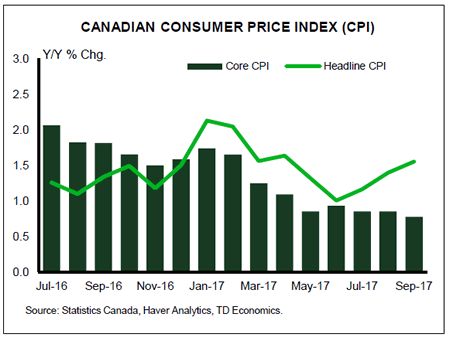U.S. Highlights
- With little to digest on the data front, attention was devoted to political developments this week. Stock markets remained upbeat through Wednesday, given optimistic expectations on tax reform, supportive earnings reports and gains among energy stocks.
- However, market sentiment turned down thereafter, as developments on tax reform failed to meet expectations, given key differences between the House bill and the newly-released Senate bill.
- While tax reform will remain top of mind in the days ahead, a number of important data releases next week will help tilt the narrative back toward economic fundamentals, with emphasis placed on the upcoming CPI report.
Canadian Highlights
- The WTI crude oil benchmark jumped to over $57 per barrel, reaching the highest level seen since mid-2015.
- In a speech this week, Governor Poloz maintained a dovish tone, focusing on the softness in inflation. Further rate hikes remain highly data dependent.
- Housing starts increased in October, erasing some of September’s decline. However, with higher interest rates and new B20 measures weighing on demand, starts are likely to gradually slide in the coming quarters.
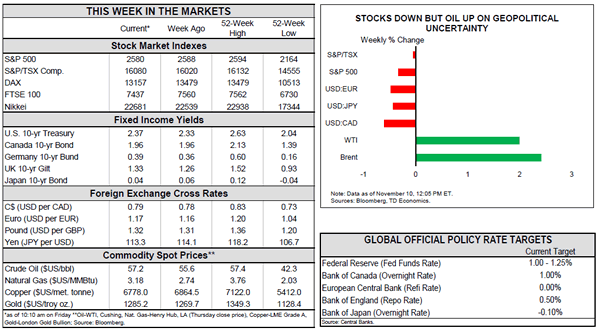
U.S. – Tax Bills: When Two Is Not Better Than One
This week was exceptionally quiet in terms of economic data. There were no primary reports released and second-tiers did little to spur market action. On that front, JOLTS job openings and weekly jobless claims saw little change, while consumer sentiment (U. of Michigan) pulled back in early November but remained upbeat at 97.8 – a level marking the second-highest reading this year. With little else to digest on the data front, attention was devoted to political developments.
Markets remained upbeat through midweek, given optimistic expectations on tax reform, supportive earnings reports and gains among energy stocks. The latter were buoyed by a surge in crude oil prices, with rising geopolitical uncertainty in the Middle East, particularly in Saudi Arabia, being the main catalyst behind the move (Chart 1). Global demand has been strong and OPEC discipline is expected to continue, but the risks for oil prices are skewed to the downside as non-OPEC production is on the rise, particularly U.S. shale. The EIA reported that U.S. production reached 9.62 million (B/D) last week, which is at the top range of historical highs.
Market sentiment followed a more downbeat tone later in the week, as developments on tax reform, which appeared to overshadow headlines from the President’s Asia trip, failed to meet expectations. While the Ways and Means Committee advanced the House bill on Thursday, preparing for a vote by the full House next week, the Senate released its own version of the bill, with preliminary reporting pointing to some key differences among the plans. For instance, the Senate bill retains the current seven-bracket income tax structure with a new top rate of 38.5% as opposed to the reduced four-bracket structure in the House bill, it doubles the estate tax exemption but does not eliminate it after 2024, and it eliminates state and local tax deductions (SALT) without keeping a 10k deduction on property tax. Moreover, the Senate bill would delay corporate tax cuts to 2019 as opposed to implementing them in 2018, and takes a different approach on pass-through taxation, creating a new 17.4% deduction, as opposed to lowering the rate to 25% as in the House bill.
In short, there are enough differences between the two bills to make immediate passage less likely. Much rides on tax reform, with expectations for major change being one of the main supporting factors behind the impressive post-election gains in stock markets (Chart 2). As such, the delay is likely to weigh on near-term sentiment, with prospects for a later introduction of corporate tax cuts of particular concern to investors.
Tax reform is likely to remain top of mind in the days ahead, but a number of important data releases next week will help tilt the narrative back toward economic fundamentals. Hurricane-related volatility should begin to taper off in upcoming reports, supporting the Fed’s decision-making process. With the economy still on a solid course and the labor market tightening further, we remain of the view that the Fed will hike rates once more by year’s end. But, this will require some cooperation from inflation metrics, with the emphasis placed on next week’s CPI report.
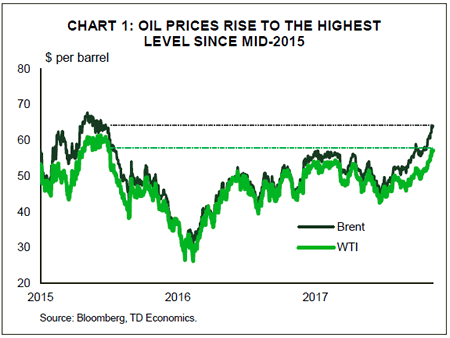
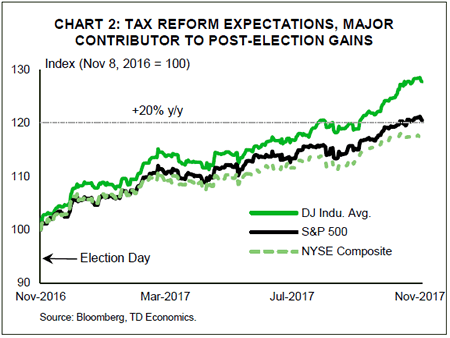
Canada – Oil Prices Hit A 2-year High
It was a fairly quiet week in Canada, with housing starts data and a speech from Bank of Canada Governor the only major events. Still, the S&P/TSX managed to hit a record high early in the week, helped along by rising oil prices. The WTI benchmark jumped nearly $2 to over US$57 per barrel – the highest level seen since mid-2015.
There has been some fundamental support for oil prices recently as OPEC and the group of non-OPEC members indicated that they plan to extend production cuts through the end of 2018 in order to ensure the market returns to a more balanced position. But the jump this week was triggered by Saudi Arabia’s King ordering the arrest of several royal, political, and business officials in an attempt to crackdown on corruption. This sparked concern in the market over the stability in one of the world’s top oil producing countries, and signaled to markets that power in the kingdom was consolidating with those in favour of extending production cuts.
Given that the latest move up has been based more on geopolitical risk rather than proof of an improvement in the global market balance, prices are unlikely to gain much more ground. Moreover, with prices at current levels, non-OPEC producers – particularly US shale producers – are likely to increase hedging activity, supporting higher production going forward. What’s more, OPEC’s latest forecast shows US output expected to grow at a faster pace than previously thought, slowing the overall balancing process. All told, there is more downside risk for oil prices than upside, with prices just over US$50 per barrel likely for the foreseeable future.
Oil’s steep rise has not benefited the Canadian dollar, with the typical positive relationship between the two having broken down in recent weeks. It appears as though the loonie is responding more to monetary policy expectations at present. On that front, following two rate hikes earlier this year, the Bank of Canada has switched to a more dovish tone. In his speech this week, Governor Poloz focused on the softness in inflation, but also maintained ‘optionality’ going forward, consistent with data dependence as it ensures the economy is unfolding as expected. The risks to the Canadian economy are skewed to the downside, with uncertainty surrounding NAFTA and recently implemented/announced measures aimed at cooling the housing market two key risks. Still, our (and the Bank of Canada’s) forecast is for continued economic growth, and at this point we continue to expect another rate hike in early-2018.
This will add to the tightening in monetary policy that has already occurred this year, as well as the new B20 measures that are set to come into effect in January. As such, demand for housing is expected to slow in the coming quarters. Housing starts data out this week showed a slight bounce back in October, erasing some of September’s decline. The 6-month moving average is now sitting at 217k units, which is a healthy pace of homebuilding activity. But, given the headwinds facing demand, starts are likely to edge down over the next year as they move toward more demographically sustainable levels.
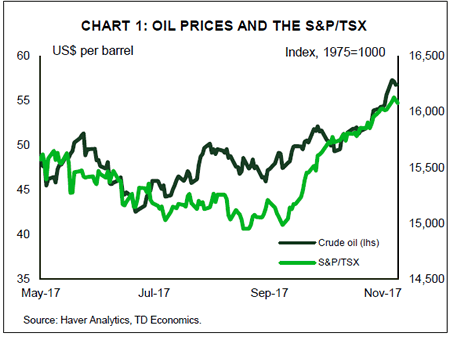
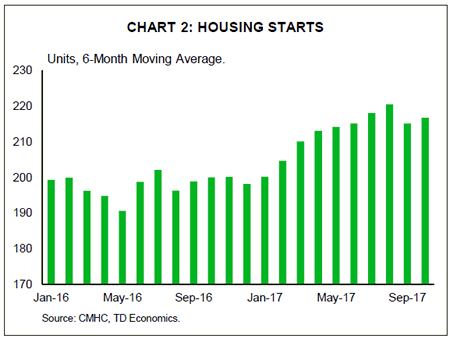
U.S.: Upcoming Key Economic Releases
U.S. Consumer Price Index – October
Release Date: November 15, 2017
Previous Result: 0.5% m/m, core 0.1% m/m
TD Forecast: 0.1% m/m, core 0.2% m/m
Consensus: 0.1% m/m, core 0.2% m/m
We expect headline CPI inflation to slip back to 2.0% y/y in October, with prices up 0.1% m/m. Energy prices should be a drag, led by declines in gasoline prices which will give back some of their hurricane-induced strength. We expect core CPI to print a 0.2% m/m increase though serial disappointment keeps us cautious. A firmer read in October is possible on a rebound in core goods prices, helped by higher vehicle prices. Shelter prices, which moderated in September, also have scope for a pickup, keeping the upward pull in core services in check. We expect core inflation to be stable at 1.7% y/y.
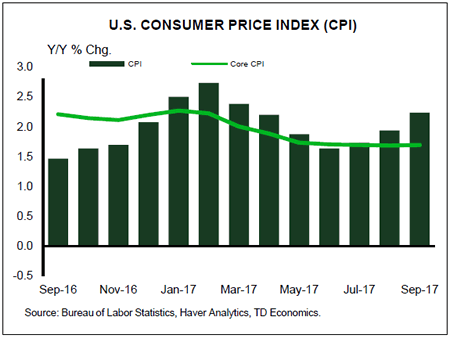
U.S. Retail Sales – October
Release Date: November 15, 2017
Previous Result: 1.6%, ex-auto 1.0%, control 0.4%
TD Forecast: 0.3%, ex-auto 0.2%, control 0.4%
Consensus: 0.0%, ex-auto 0.2%, control 0.3%
We believe another strong retail sales report is in the cards for October, with headline sales rising 0.3% on a solid 0.4% in the core control group. The August-September hurricanes that propped up spending in September, specifically for autos, grocery stores and restaurants, and building materials, have scope for a sustained tailwind into October. New vehicle sales should be only a modest drag as the reported figures showed a smaller than expected moderation (18.0m vs 18.5m), offloading a solid landing for Q4 consumer spending. Gasoline station receipts should also lend a negative contribution on lower gasoline prices. We expect the report to reinforce Q4 real PCE tracking estimates near a 2% pace.
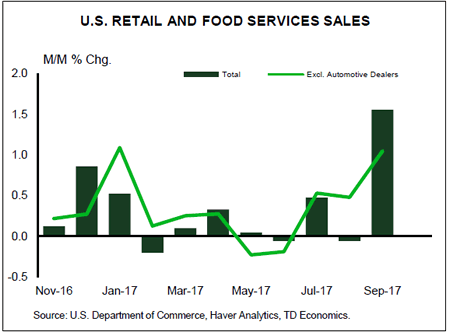
Canada: Upcoming Key Economic Releases
Canadian Manufacturing Sales – September
Release Date: November 16, 2017
Previous Result: 1.6% m/m
TD Forecast: -0.7% m/m
Consensus: -0.2% m/m
Manufacturing sales for September will be distorted by labour market disruptions in motor vehicle production. We look for a pullback of 0.7% on the month, with the transportation sector driving the decline. General Motors workers were on strike for roughly half of the month which could leave factory sales of motor vehicle down 5-10% m/m in line with the performance in exports. However, energy products will provide a key offset due to increased foreign demand and a sizeable tailwind from gasoline prices. Outside of motor vehicles and energy, we see few reasons to be upbeat. Ex-petrol producer prices saw a broad decline in September and hours worked in manufacturing were on the weak side. Manufacturing sales should see a more modest pullback in real terms. This will provide a soft handoff to Q4 though we still see exports rebounding due to one-off factors that hampered auto production in the third quarter.
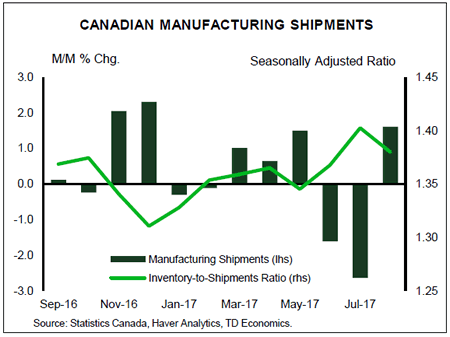
Canadian Consumer Price Index – October
Release Date: November 17, 2017
Previous Result: 0.2% m/m, 1.6% y/y
TD Forecast: 0.0% m/m, 1.3% y/y
Consensus: 0.1% m/m, 1.4% y/y
Headline CPI was likely flat on the month, reflecting a drag from gasoline prices, which would cause the headline inflation rate to slow to 1.3% y/y vs 1.6% y/y due in part to unfavourable base effects. Headwinds from the past strengthening in the Canadian dollar – non-petroleum import prices fell by 20% annualized in Q3 – are built into this forecast as well. Sector-specific effects also pose downside risks, such as a continued decline from telephone services prices due to heightened competition in the sector from the unveiling of cheaper data plans. Meanwhile, we expect shelter prices to gain steam after a relatively weak month, in line with the resurgence in housing activity in Toronto and Vancouver. Food prices also have scope for sustained strength though remain vulnerable to past exchange rate appreciation. Special attention will be given to exclusion-based core measures (ex food and energy and CPIX) which are currently underperforming the BoC’s preferred core measures – an indication that transitory one-off factors are driving the recent disappointment in inflationary pressures. These factors will be important to keep in mind in the months to come as further weakness could stay the Bank’s hand. But alongside sustained improvement in the trend-based measures, which suggests that slack continues to dissipate, we expect the BoC to look through below-target inflation, setting the stage for a January rate hike. It should also be noted that even with the past sources of downward pressures, 2% inflation remains in sight with our current forecast now showing inflation back to target as early as March.
